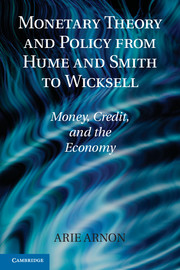Book contents
- Frontmatter
- Dedication
- Contents
- List of Illustrations
- List of Tables
- Preface
- Introduction
- Part one Analytical and Historical Foundations
- Part two Debating Monetary Theory under Inconvertibility
- Part three Debating
- Part four The Road to Defensive Central Banking
- Part five A New Beginning
- 17 Wicksell’s Innovative Monetary Theory and Policy
- 18 The Puzzling Slow Rise of a Theory of Central Banking
- Epilogue
- Bibliography
- Author Index
- Subject Index
18 - The Puzzling Slow Rise of a Theory of Central Banking
Between Lender of Last Resort, Defensive, and Active Monetary Policies1
Published online by Cambridge University Press: 05 July 2014
- Frontmatter
- Dedication
- Contents
- List of Illustrations
- List of Tables
- Preface
- Introduction
- Part one Analytical and Historical Foundations
- Part two Debating Monetary Theory under Inconvertibility
- Part three Debating
- Part four The Road to Defensive Central Banking
- Part five A New Beginning
- 17 Wicksell’s Innovative Monetary Theory and Policy
- 18 The Puzzling Slow Rise of a Theory of Central Banking
- Epilogue
- Bibliography
- Author Index
- Subject Index
Summary
Introduction
As the story told in this book has shown, monetary theorists from the mid-eighteenth century to the 1870s, with a few exceptions, focused on analyzing what they perceived as the preferred structure of the monetary system – a system founded on convertibility of bank notes to the precious metals – and how that system could best support the real economy. A critical issue – explicit or sometimes implicit – was the attitude of scholars toward interventions in the monetary system and in the financial sector more generally. The very idea of intervention contradicted, of course, the invisible hand approach to money and banking so typical of the founders of classical monetary theory, David Hume and Adam Smith. Hence, a detailed assessment of the few proposals in favor of intervention may help identify early thoughts about alternatives to the invisible hand – alternatives that came to be known in the twentieth century as monetary policy or central banking. One has to remember that, to the surprise of many modern economists, there was no accepted theory of central banking even as late as 1873, when Walter Bagehot first attempted to develop one with the publication of Lombard Street. We will argue in this chapter that his theory was not a fully developed theory of central banking. Such a theory had to wait for Knut Wicksell’s path-breaking 1898 text, Interest and Prices, and his later Lectures on Political Economy.
- Type
- Chapter
- Information
- Monetary Theory and Policy from Hume and Smith to WicksellMoney, Credit, and the Economy, pp. 370 - 398Publisher: Cambridge University PressPrint publication year: 2010

